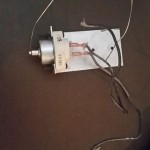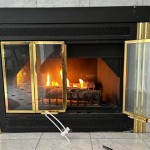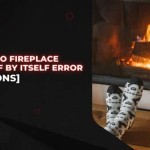Multi-Sided Fireplaces: A Comprehensive Guide
Multi-sided fireplaces, also known as see-through, peninsula, or island fireplaces, are architectural features designed to provide a view of the fire from multiple angles. These fireplaces serve as focal points, room dividers, and aesthetic enhancements in residential and commercial spaces. Their appeal lies in their ability to connect different areas visually while offering warmth and ambiance. The design and installation of a multi-sided fireplace require careful consideration of structural integrity, ventilation, safety regulations, and fuel type.
The evolution of fireplace design has progressed from rudimentary single-sided hearths to sophisticated multi-faceted configurations. Historically, fireplaces primarily served a functional purpose by providing heating and cooking capabilities. As architectural styles evolved, fireplaces became increasingly integrated into the design of living spaces. The introduction of multi-sided fireplaces represents a significant advancement, allowing for greater flexibility in room layout and visual connectivity. This design promotes a more open and inviting atmosphere, especially in contemporary homes and buildings.
The selection of a multi-sided fireplace involves several key considerations, including the physical space, budget, and desired aesthetic. These factors will influence the choice between gas, wood-burning, and electric options. Each type offers distinct advantages and disadvantages concerning installation complexity, fuel costs, and environmental impact. Furthermore, the architectural style of the space and the intended use of the fireplace will dictate the appropriate design and placement. Close coordination with architects, contractors, and fireplace specialists is essential to ensure a successful installation that meets all applicable building codes and safety standards.
Advantages of Multi-Sided Fireplaces
Multi-sided fireplaces offer a range of benefits that contribute to their growing popularity in modern architecture and interior design. These advantages include enhanced visual appeal, improved spatial connectivity, and efficient heat distribution. By providing multiple viewing angles, these fireplaces create a dynamic and engaging focal point within a room. They can also serve as functional room dividers, defining distinct areas while maintaining an open and airy feel. The ability to distribute heat more evenly across multiple spaces can also lead to increased energy efficiency and comfort.
One of the primary advantages of a multi-sided fireplace is its ability to create a visually stunning centerpiece that can be enjoyed from multiple locations within a room or even adjacent rooms. This is particularly beneficial in open-concept living spaces, where the fireplace can act as a unifying element that ties together different areas. The flickering flames and glowing embers provide a sense of warmth and ambiance that enhances the overall atmosphere of the space. Moreover, the design flexibility of multi-sided fireplaces allows for integration with various architectural styles, from traditional to contemporary.
Another significant benefit is the enhanced spatial connectivity that multi-sided fireplaces provide. Unlike traditional fireplaces that are typically confined to a single wall, multi-sided fireplaces can be strategically positioned to connect different areas visually. This can create a more cohesive and inviting environment, particularly in larger homes or commercial spaces. The open design allows for natural light to flow more freely, reducing the need for artificial lighting and creating a more sustainable and energy-efficient environment. The visual connection also fosters a sense of community and interaction, making it ideal for social gatherings and family time.
Furthermore, multi-sided fireplaces can offer efficient heat distribution compared to traditional single-sided models. By radiating heat from multiple surfaces, these fireplaces can warm a larger area more evenly. This can result in improved energy efficiency and reduced heating costs, especially when used as a supplemental heating source. The distribution of heat can also be optimized by carefully considering the placement of the fireplace and the design of the surrounding spaces. Proper insulation and ventilation are crucial to maximize heat retention and prevent drafts, ensuring a comfortable and energy-efficient environment.
Types of Multi-Sided Fireplaces
The market offers several types of multi-sided fireplaces, each with unique characteristics and fuel options. The three primary types are gas, wood-burning, and electric. Gas fireplaces are known for their convenience, ease of use, and clean burning properties. Wood-burning fireplaces offer a traditional aesthetic and the authentic crackling sound of burning wood. Electric fireplaces provide the flexibility of placement and ease of installation without the need for venting or fuel lines. Each type has its own set of considerations regarding fuel costs, maintenance requirements, and environmental impact.
Gas multi-sided fireplaces are a popular choice due to their ease of use and convenience. They offer instant ignition and adjustable flame height, providing precise control over the heat output. Gas fireplaces can be fueled by either natural gas or propane, depending on the availability of a gas line. They also offer a clean burning flame, producing fewer emissions compared to wood-burning fireplaces. The installation of a gas fireplace requires a professional to ensure proper connection to the gas line and compliance with safety regulations. Regular maintenance, such as cleaning the burner and inspecting the venting system, is essential to ensure optimal performance and safety.
Wood-burning multi-sided fireplaces provide a traditional aesthetic and the authentic experience of burning wood. They offer a natural and rustic ambiance that is highly sought after by many homeowners. However, wood-burning fireplaces require more effort in terms of fuel management and maintenance. The wood needs to be properly seasoned and stored, and the fireplace requires regular cleaning to remove ash and creosote buildup. The venting system must be inspected and cleaned regularly to prevent chimney fires. Despite the additional effort, wood-burning fireplaces provide a unique and satisfying experience that cannot be replicated by other types of fireplaces.
Electric multi-sided fireplaces offer the greatest flexibility in terms of placement and installation. They do not require venting or fuel lines, making them suitable for a wide range of locations. Electric fireplaces use electric resistance heating to generate heat and often include realistic flame effects to mimic the appearance of a real fire. They are easy to operate and maintain, requiring minimal effort. Electric fireplaces are also energy-efficient, as they can be used without producing heat, allowing homeowners to enjoy the ambiance of a flame without increasing their energy consumption. While they may not provide the same level of heat as gas or wood-burning fireplaces, electric models are a convenient and versatile option for adding warmth and ambiance to any space.
Design and Installation Considerations
Designing and installing a multi-sided fireplace requires careful planning and attention to detail. Key considerations include structural support, ventilation systems, safety regulations, and material selection. The weight of the fireplace and chimney system must be adequately supported by the building's structure. Proper ventilation is essential to ensure safe and efficient operation, regardless of the fuel type. Compliance with local building codes and safety regulations is paramount to prevent hazards and ensure the long-term integrity of the installation. The choice of materials should complement the architectural style of the space and provide durability and aesthetic appeal.
Structural support is a critical aspect of multi-sided fireplace installation. The fireplace and chimney system can be quite heavy, requiring adequate support from the foundation and framing. A structural engineer should be consulted to assess the load-bearing capacity of the building and design appropriate support structures. This is particularly important for multi-story homes or buildings with complex architectural designs. Failure to provide adequate structural support can lead to structural damage and potential safety hazards. The support system should be designed to withstand not only the static weight of the fireplace but also dynamic forces such as wind and seismic activity.
Ventilation is essential for the safe and efficient operation of multi-sided fireplaces, especially for gas and wood-burning models. Proper ventilation ensures that combustion gases are safely exhausted from the building, preventing the buildup of harmful carbon monoxide. Gas fireplaces require a direct vent system that draws air from outside the building and exhausts gases directly outside. Wood-burning fireplaces require a chimney system that provides adequate draft to draw smoke and gases up and out of the building. The venting system must be properly sized and installed to ensure optimal performance and prevent backdrafts. Regular inspection and cleaning of the venting system are crucial to prevent blockages and maintain proper ventilation.
Compliance with local building codes and safety regulations is paramount when installing a multi-sided fireplace. Building codes specify the minimum requirements for fireplace construction, ventilation, and safety features. These codes are designed to protect occupants from fire hazards and ensure the safe operation of the fireplace. A qualified contractor should be familiar with local building codes and obtain the necessary permits before starting the installation. Safety features such as smoke detectors, carbon monoxide detectors, and fire extinguishers should be installed in accordance with code requirements. Regular inspections by a certified professional can help to identify potential safety hazards and ensure ongoing compliance with safety regulations.

Multi Sided Fireplaces Zoroast The Fireplace
Multi View Scotts Fireplace

Multi Sided Fireplaces Zoroast The Fireplace

Valor Lx2 Multi Sided Fireplace Vaglio

Lx2 3 Sided Corner Gas Fireplace Natural The Center
Pier Direct Vent Gas Fireplace Majestic S

Multi Sided Gas Fireplaces Montigo

Modern Flames Orion Multi Sided 60 Inch Heliovision Virtual Smart Built In Electric Fireplace Or60 Fireplaces Depot

Multi Sided Gas Fireplaces

Sedona Pro Multi Sided Electric Fireplace Spm 3026 The
Related Posts








